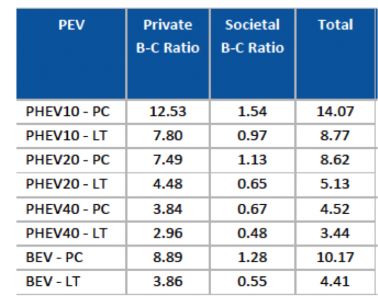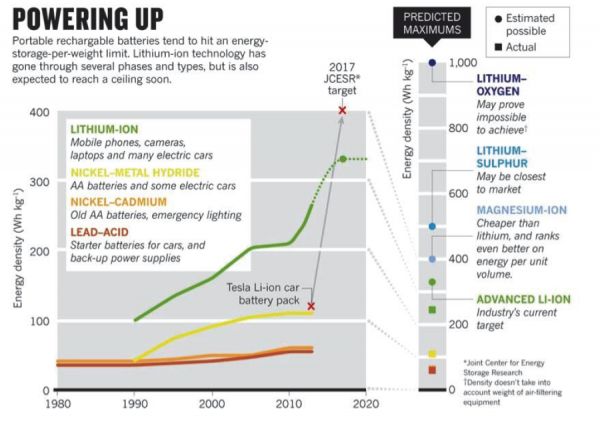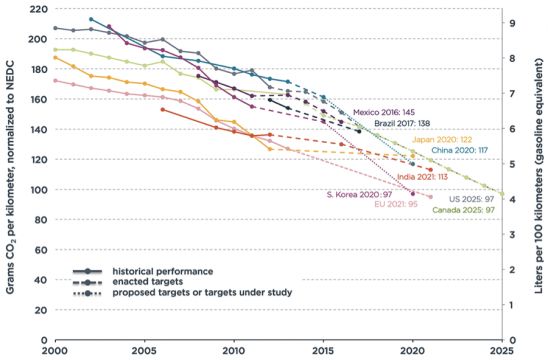There are now over two dozen all-electric and plug-in hybrid electric vehicles on the market and at least two dozen additional models that are slated to be available in the next couple of years. Mercedes alone just announced that it will be offering 10 different plug-in hybrid models in the next couple of years, following a similar announcement by BMW in March.
The world’s best-selling EV is still the Nissan Leaf, a modest little passenger vehicle, with over 165,000 units sold by March of this year since its release in late 2010. A new study found that the batteries have been very reliable, with 99.99 percent of the 35,000 Leafs sold in Europe still working perfectly.
The Mitsubishi Outlander PHEV and the Tesla Model S are the second and third best-selling EVs today, respectively, even though the Outlander hasn’t yet been made available in the U.S.
Total global sales of EVs/PHEVs amounted to 320,000 units in 2014, an 80 percent rate of growth and on pace to easily exceed 500,000 in 2015. Cumulative sales reached 740,000 vehicles by the end of 2014 and will top 1 million by the middle of 2015. That is still less than 1 percent of the global auto market, but it shows that EVs and PHEVs are here to stay. Global vehicle sales are projected to reach approximately 89 million units in 2015. If global EV sales reach 500,000, this will equate to about 0.6 percent, putting us on track to reach 1 percent of global sales in 2016.
As I described in a previous column, 1 percent is halfway to market dominance in terms of the doublings required to get from nothing to 1 percent and then from 1 percent to 100 percent. It takes seven doublings to get from 1 percent to over 100 percent and the same to go from nothing to 1 percent.
Figure 1: Global EV Sales Through 2014

Source: Centre for Solar Energy and Hydrogen Research
In this column, however, I’m not going to talk about the magnitude of sales in the future. Rather, the future I’m focused on here is the future of EV technology itself. How will EVs evolve in the next decade, the years that are already a little bit visible on the horizon? I’ll focus on three main trends: 1) improving battery technology; 2) lightweighting of vehicles; and 3) automation. Sorry, no (mass-market) flying cars are around the corner -- yet.
Improving battery technology
We can learn a lot by looking at learning curve models for batteries. Today’s prevailing battery technology for EVs is lithium-ion. It’s good, but far from perfect. Even though today’s lithium-ion batteries hold two and a half times the energy they did in 1991 and cost 10 times less, lithium-ion technology is still too energy-diffuse and expensive compared to where it needs to be to become truly mainstream. But we’re well on the way. Figure 2 shows the various battery technologies and fuel cells in terms of their energy density.
Figure 2: Energy Density of Battery and Fuel-Cell Technologies

Source: Nature (http://www.nature.com/news/the-rechargeable-revolution-a-better-battery-1.14815)
The current holy grail for EV batteries is getting costs down to $100 per kilowatt-hour, down from $250 to $300 per kilowatt-hour today. The expectation is that at this cost, EVs can compete with internal combustion vehicles without subsidies. The exciting development in the last year is that not only is Tesla’s Musk saying that the firm hopes to reach this level in the next decade with production from its Giga factory, but that others are agreeing with him, including the Motley Fool, the independent financial research entity.
Lithium-ion batteries will probably start showing marginal improvements around that time, however, in terms of continuing cost declines and increasing energy density. Most experts today think that lithium-ion batteries will top out at around 400 watt-hours/gram or even less, up from around 250 today. Around that point, it’s likely that we’ll see markets shift toward different technologies in order to continue the trend toward increased energy density.
One new technology that shows promise is lithium-air (also known as lithium-oxygen), which uses ambient air to aid energy flows and results in less degradation than seen in other types of batteries. The long-term holy grail of lithium-air batteries is achieving an energy density on par with gasoline, which is theoretically achievable with this technology, and would allow batteries to take up much less space than they do today. The technology would offer about 10 times the energy density of today’s batteries.
However, the future is not at all clear for lithium-air batteries, and some researchers think they’re a lost cause. Others aren’t ready to bow out yet, including Peter Bruce of the U.K.'s University of St. Andrews: “We are closer to what’s needed than we were a few years ago.
As with Moore’s law and the speed and cost of computing power, we can expect to continue to see major improvements in battery technology in the coming decade. With Tesla and Panasonic throwing literally billions of dollars behind improved lithium-ion batteries, it’s likely that lithium-ion will remain the go-to battery technology for EVs in the next decade. It’s also possible, however, that other types will make major breakthroughs in that same time period and reach the broader market.
My best bet is that we’ll continue to see incremental improvements in lithium-ion energy density, but also continue to see steady decreases in costs. This is the case because costs will decline based on increases in the scale of production and learning curve effects relating to this scale and associated manufacturing techniques, independent of any major improvements in the actual architecture of the batteries. Such improvements will be icing on the cake, but probably not necessary to achieve major improvements over today’s density and costs
Lightweighting
Interestingly, we can achieve exactly the same improvement in EV range or reduction in costs by making cars lighter as we can by making more energy-dense batteries. And it may actually be easier to do it by making cars lighter, because there is less of a diminishing return phenomenon in taking today’s relatively heavy cars and making them lighter with the use of new materials and techniques.
We’re already seeing many technologies leading to lighter and more efficient cars, regardless of whether the cars are electric or gasoline or diesel. Some kind of fuel economy standard is in place now for 80 percent of the world’s passenger vehicle market, according to the International Council on Clean Transportation. Figure 3 shows the vehicle fuel-efficiency standards for the world’s largest economies at the end of 2014. The general trend that's predicted is a 50 percent reduction in the emissions from passenger vehicles between 2000 and 2025. We’re about halfway to achieving that goal, and it is realistic to expect that the 2020-2025 goals will be met due to the many new technologies arriving that will improve fuel efficiency and decrease GHG emissions.
Figure 3: Vehicle Fuel Efficiency Standards for Various Countries

Source: ICCT
As a consequence of these trends (and many others), IEA projects, in its 2015 World Energy Outlook, that oil demand will rise to 104 million barrels per day by 2040, up from 91 mbpd in 2014. This is a significant increase, but it’s a large decline from previous forecasts that reflects the increasing role of improved vehicle fuel efficiency around the world. We can anticipate additional vehicle fuel efficiency to materialize in the coming decades, going far beyond the 52.5 miles per gallon requirement under the U.S. CAFÉ standard for 2025.
Many EVs are already quite small. The smallest commercially available model is the Renault Twizy, with over 15,000 already on the road in Europe (it’s not available in the U.S.). The Fiat 500e is tiny (I should know since I drive one), and the Smart ForTwo EV is even smaller. Are we destined for a future filled with electric go-karts? Well, we’ll surely have many more of these truly tiny vehicles on the road, particularly in dense urban areas, but we’re also going to see plenty of normal-size cars becoming increasingly lightweight.
Amory Lovins and the Rocky Mountain Institute have for many years pioneered the “Hypercar” idea that includes a radical redesign when it comes to weight. Lovins describes many aspects of this vehicular evolutionary process in his 2011 book, Reinventing Fire. He states: “Investing R&D effort in vehicle fitness (which got about a hundredfold less in U.S. research budgets through 2010) will yield the same result [as better batteries] with less cost, time, and risk.”
Ford made big news recently by announcing its use of aluminum for much of the frame in its top-selling F-150 line of trucks. The 2015 model is 700 pounds and about 15 percent lighter due to this shift from using steel in favor of using aluminum. Ford is claiming up to a 20 percent improvement in fuel efficiency, due largely to this change in weight. The aluminum used in these trucks is about twice as strong as steel and thus safer in accidents, as well as lighter.
Steel is not giving up without a fight, however, and some companies are planning to use high-strength steel to reduce the weight of cars rather than alternatives like aluminum. ArcelorMittal, a steel manufacturer, released a survey suggesting that pickup trucks could achieve an average 23 percent improvement in weight by using the new high-strength steel products combined with expected improvements in powertrains.
One idea that Lovins has highlighted for years is also starting to come to fruition: carbon fiber vehicle bodies. The BMW i3 compact hatchback is far lighter than comparable cars because, in part, its body is made mostly of carbon composites, the same stuff that modern airplanes are increasingly being made from. This is the first car (let alone EV) to use primarily carbon fiber for its body. Carbon fiber is 30 percent lighter than aluminum and actually stronger. The i3 weighs 2,635 pounds, significantly less than the average weight of 3,000-4,500 pounds for the typical compact car. The Chevy Volt, for example, another highly fuel-efficient car and also officially a compact car, weighs 3,786 pounds. Even the tiny Fiat 500e weighs more than the i3, at 2,980 pounds.
The i3 represents a big shift in long-term trends in car weight, because after a massive drop in the 1970s, in response to the oil crises, most vehicles steadily gained weight from the 1980s through to the present. We can expect, with the federal CAFÉ standards for 2025 being quite aggressive, that other automakers will follow BMW’s lead in terms of using new materials in a long-term quest to create much lighter cars.
Over 20,000 i3s have been sold worldwide since its late 2013 release, and by all accounts, it’s a great car with no issues relating to its carbon frame. U.S. sales of over 1,000 vehicles in February 2015 put the i3 at third place after the Nissan Leaf and Tesla Model S and well above the Chevy Volt and Prius Plug-in hybrid.
Automation
We’re also going to see cars become far more automated. It seems that the hurdles to driverless cars are now largely legal rather than technical, and my feeling is that we’ll have fully autonomous cars in the next few years -- and maybe even sooner for some models.
Tesla has earned a lot of attention when it comes to driverless cars, and it may well lead the pack to achieving a fully autonomous vehicle. Musk has announced a suite of “autopilot” capabilities that are coming via software update this summer to the company’s signature Model S. Musk stated that the new features could in theory allow the car to drive itself from parking lot to parking lot on long drives throughout much of the U.S., but for now, it will be limited to highway driving due to the legal obstacles currently in place.
Many other brands are also working on fully autonomous cars, and most luxury cars have an increasingly sophisticated suite of automated driving abilities. The Audi A7 completed a test drive with its autopilot from the Stanford campus in Palo Alto to Las Vegas, Nev. earlier this year without incident. Mercedes and Cadillac models also have many autopilot features already included, with surely many more features to come.
In sum, it seems pretty likely that we’ll have fully autonomous cars by 2020 or even sooner. That’s pretty cool, and I personally look forward to telling my car to take me to Yosemite for the weekend as I kick back for a nap.
A future column will look at even more exotic aspects of the future evolution of the cars we drive -- and that increasingly will be driving us.
***
Tam Hunt is a lawyer and writer, and author of the upcoming book The Solar Singularity: Why Our Energy Future Is So Bright.



